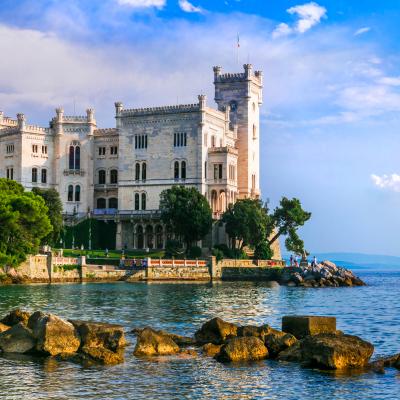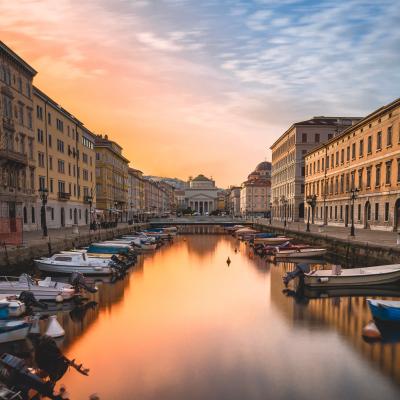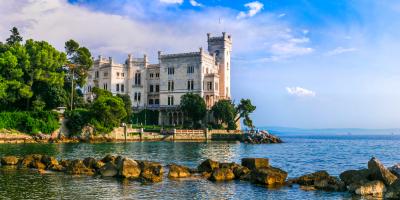Friuli-Venezia Giulia
Friuli-Venezia Giulia is a borderland in many senses; it is a Special Statute Region in northeastern Italy with its capital Trieste. It takes its name from the two historical-geographical regions: Friuli, (Provinces of Pordenone, Udine and Gorizia), and Venezia Giulia (Province of Trieste), which, with Veneto and Trentino-Alto Adige, form the geographical area of Triveneto.
Few regions worldwide boast such a wide cultural, natural, food and wine, and folkloric variety in such a limited territory. A special-status region, it comprises two areas that are quite distinct from each other in terms of history and tradition: Friuli (provinces of Udine and Pordenone) and Venezia Giulia (provinces of Trieste and Gorizia). The region boasts a very rich historical and cultural heritage: each center has its own museum and manages to surprise with its plurality of architectural styles.
The Friuli Venezia Giulia part of the region consists of mountainous territory with valleys and rivers, including the Tagliamento and Fella. There are the Friulian Dolomites whose peaks also reach about 2,800 meters. South of the Julian Pre-Alps is the Karst plateau, which reaches almost to the coast washed by the Adriatic Sea. The hilly area lies south of the mountainous area and along the central part of the border with Slovenia. The flat area that reaches from the hills to the Adriatic Sea is part of the so-called Friulian plain, belonging to the Veneto-Friuli plain, and is usually distinguished into alta and bassa friulana.
The climate is varied: it ranges from sub-Mediterranean in the coastal areas, to temperate and more humid in the plains and hilly areas, to alpine climate in the mountains. The marine area enjoys one of the driest climates in Italy. Bora, Scirocco, Mistral, breezes-the winds that sweep the coast alternate throughout the year and characterize these areas. The mountains have a more rigid and rainy climate, with snow even at lower altitudes.
The Cities and the Coast
Trieste is the most centrally located Italian city in Europe, rich in history and culture, boasting an ancient and modern artistic heritage of the highest value. The city's elegance shines through in its buildings that speak in the neoclassical, Art Nouveau, eclectic and Baroque idioms. The historic center offers many testimonies of history and art including the Riccardo Arch, the 14th-century cathedral, and the castle of San Giusto. A special charm emanates from Piazza dell'Unità d'Italia, clearly Viennese in style, surrounded on three sides by neoclassical buildings, while the fourth side opens onto the sea. On the coastal stretch is the wide gulf that welcomes the city of Trieste with its harbor and breathtaking cliffs with castles overlooking the sea, including the spectacular Miramare Castle. Among the highlights of Friuli - Venezia Giulia is the ancient city of Aquileia, one of the most important centers of the Roman Empire. Declared a UNESCO World Heritage Site, Aquileia is rich in testimonies such as the forum, the remains of the river port and the Basilica, one of the highest examples of early Christian art.
Tourism is well-developed, especially in the seaside resorts of Lignano Sabbiadoro and Grado, in the historic center of Udine, and thanks to the many agritourisms and vineyards. In the winter season the alpine resorts (Piancavallo, Tarvisiano, Ravascletto, and Forni di Sopra) are popular for ski destinations. Other towns worth visiting are Gorizia and Pordenone. The pristine environments of Friuli - Venezia Giulia offer a thousand opportunities for an unforgettable vacation of physical activity, wellness and fun. The various protected areas allow for walking and nature trails: from the Cavanata Valley Reserve, also suitable for birdwatching, to the Dolomites Natural Park, the realm of mountaineering and climbing. For a regenerating vacation dedicated to health, wellness and beauty, you can reach the renowned spas, including the Terme di Grado.
What to eat
The regional cuisine is simple and original, the result of the meeting of the great Italian tradition with that of the German and Slavic worlds. The typical product par excellence is San Daniele ham, known and exported all over the world, followed by Montasio DOP cheese and Sauris smoked ham. Among the sausages, salami, soppresse, sausages and musèt con la brovada, that is, cotechino served with turnips soured in marc, stand out. Characteristic dishes are polenta, porcina, composed of boiled pork and sausages served with sauerkraut and mustard, soups and vegetable and legume soups. Savory and tasty is the jota, made with potatoes, beans, sausage and sauerkraut. Beloved is gulash, which originated in Hungary and soon spread throughout the Habsburg Empire.
As for main courses, lamb al Kren (with horseradish) and polenta concia prepared with montasio are the strong and tasty dishes. Popular are pheasant, hare, wild boar and venison to be cooked in various ways. On the Adriatic you can try fish specialties: canocchia alla busara, sardines in savor, and crabs triestina style. The most popular regional dessert is gubana, a pastry shell filled with dried fruit. Also delicious are strudels, fruit cakes and palacinke (crepes stuffed with nuts). And what about the wine production of Friuli - Venezia Giulia? It is very rich in high quality wines, both red and white, to be paired with tasty traditional Friulian dishes, including Picolit, Refosco, Terrano, Malvasia, Tocai, and Rebula. Finally, Friuli - Venezia Giulia is also renowned for the production of distillates, including grappas, from traditional to flavored ones.




